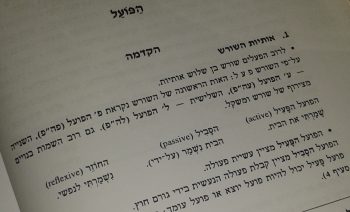The Hebrew Verb: Root and Binyanim Posted by Ayana on Jan 26, 2017 in Grammar
Hebrew verbs are small units that need to be constructed every time corresponding to the sentence context. There are three basic steps to this construction: the first includes the root. The basis of every verb is the root, since it is the one to deliver the content of the action. The second step includes the Binyanim. The verb is formed by casting the root into one of the Binyanim. Binyan is a frame that shapes the content into mood and meaning, and stresses the subject/object, passive/active. The final step of building the verb is to conjugate it according to tense and pronoun. Today we’ll delve into the first two steps: root and Binyanim.
Root שֹׁורֶשׁ
Roots are sequence of consonants, usually composed of three consonants. The designated model of the Hebrew root is פ-ע-ל, from the word פּוֹעַל (verb). This model helps us distinguish between the three consonants. The first consonant called פ’ הַפּוֹעַל. The second – ע’ הַפּוֹעַל. The third – ל’ הַפּוֹעַל.
We already learned together two roots, let’s review them again. The first one was the root כ-ת-ב (k-t-v). It is, like most of the Hebrew roots, a tri-consonantal root. The first consonant is כ. The second consonant is ת. The third consonant is ב. If we use Hebrew terminology we’ll say that פ’ הַפּוֹעַל is כ. ע’ הַפּוֹעַל is ת. ל’ הַפּוֹעַל is ב. Together these three consonants compose the content of writing. The second root we’ve already learned was a tri-consonantal root as well: the root ז-ל-ל (z-l-l). פ’ הַפּוֺעַל of this root is ז. ע’ הַפּוֺעַל is ל. ל’ הַפּוֺעַל is ל.Together these three consonants compose the content of gorging.
The root is the core of the verb. The roots’ content stay still no matter which Binyan or tense the root is cast into. The root can become verb, adjective, or noun; in the past or in the future; attached to single or plural –it doesn’t matter, it keeps its content. For example the root ז-ל-ל can be mold into words like: זַלְלָן (glutton), זְלׅילָה (overeating), זָלְלוּ (they gorged themselves).
Ready for our third root? It’s a daily useful one: ל-ב-ש (l-v-sh). It conveys the idea of wearing. It can for example mold into words like: לְבוּשׁ (clothing), לָבוּשׁ (dressed), תִּלְבֹּושֶׁת (costume), לְבׅישָׁה (wearing), לָבׅישׁ (wearable), לָבַש (He wore).
Binyanim בּׅנְיָנׅים
בּׅנְיָן is a noun, meaning building. It refers to an actual building. One can definitely walk down the street, point out and say: this is a beautiful בּׅנְיָן. In grammar terminology it has a similar meaning. It is a firm structure, into which the root is inserted, to form the verb.
We have seven בּׅנְיָנׅים in Hebrew. Each בּׅנְיָן portrays a particular aspect of the root. The same root can be embedded into different בּׅנְיָנׅים, to build different verbs. The verbs may differ in meaning but still convey the same idea of the root. The root keeps its content, while the בּׅנְיָן change the subject and the object, the passive and the active.
We divide the בּׅנְיָנׅים into two groups: active and passive.
| Active Binyanim | Passive Binyanim |
| Pa`al פָּעַל | Niph`al נִפְעַל |
| Hiph`il הִפְעִיל | Pu`al פֻּעַל |
| Pi`el פִּעֵל | Huph`al הֻפְעַל |
| Hitpa`el הִתְפַּעֵל | Hitpa`el הִתְפַּעֵל |
*As you can see Binyan Hitpa`el can be both passive and active.
Now, let’s see these בּׅנְיָנׅים in action, and cast the roots we’ve learned into their frame.
The active Binyanim:
בּׅנְיָן פָּעַל:
הוּא כָּתַב
He wrote
הוּא זָלַל
He overate
הוּא לָבַש
He wore
בּׅנְיָן הׅפְעׅיל:
הוּא הׅכְתׅיב
He dictated
הוּא הׅלְבּׅיש
He dressed (someone) up
בּׅנְיָן פּׅעֵל:
הוּא כּׅתֵּב
He added (someone) as a recipient
בּׅנְיָן הׅתְפַּעֵל:
הוּא הׅתְכָּתֵּב
He corresponded with (someone)
הוּא הׅתְלַבֵּש
He was dressing up
The passive Binyanim:
בּׅנְיָן נׅפְעַל:
הוּא נׅכְתַּב
It was written
הוּא נׅזְלַל
It was gorged
הוּא נׅלְבַּש
It was worn
בּׅנְיָן פֻּעַל:
הוּא כֻּתַּב
He was added as a recipient
בּׅנְיָן הֻפְעַל:
הוּא הֻכְתַּב
It was dictated
הוּא הֻלְבַּש
He was dressing up by (someone)
As you have noticed the roots ז-ל-ל and ל-ב-ש don’t fit into all of the בּׅנְיָנׅים. Most of the roots actually don’t use all of the בּׅנְיָנׅים. Many of them, like ל-ב-ש, can fit only into four or five בּׅנְיָנׅים. Some of them, like ז-ל-ל, can fit merely into two or three בּׅנְיָנׅים. Insert them into the other בּׅנְיָנׅים won’t create any word with a meaning.
Hebrew grammar is tough. Dedicate 10 minutes a day to practice roots and Binyanim, and notice how easy it become in no time. Feel free to leave a comment and ask any questions.
לׅימּוּד נָעׅים!
Pleasant learning!
Keep Calm and Learn Hebrew

Build vocabulary, practice pronunciation, and more with Transparent Language Online. Available anytime, anywhere, on any device.




